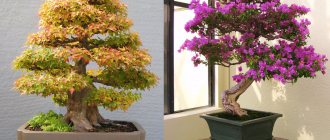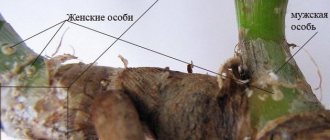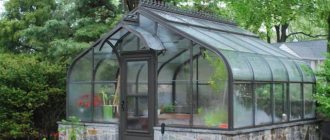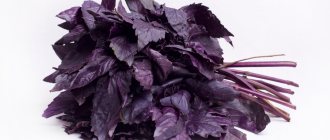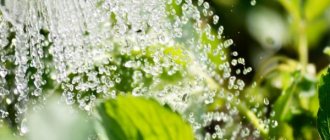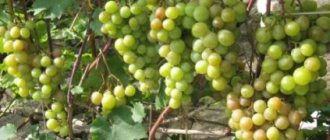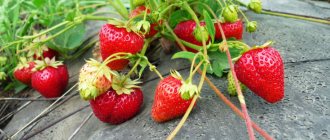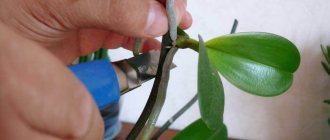Description of larch
Siberian larch is a conifer that belongs to the pine family. It is a pyramidal tree. The diameter of the crown of a young plant reaches 15 m. As it grows, the tree acquires a more rounded shape.
The bark of a young tree is light yellow in color and smooth. Over time, cracks and grooves form on it, it becomes thicker and darker. Thanks to this, the tree is reliably protected from significant temperature drops.
Siberian larch - biological description of the tree.
The wood is brownish-red in color with light beige sapwood and is resistant to rotting. A characteristic feature of this conifer is the pleasant aroma with light notes of citrus, which is exuded by young needles. Soft needles reach 5 cm in length. In spring and summer it is light green in color, with a slightly noticeable bluish tint, and with the onset of autumn it turns yellow. Another feature of this variety is its sparse crown.
Larch branches are often located at an angle of 90 degrees to the sides, smoothly bending upward. Green with a yellowish tint, annual young shoots are quite long. The needles are arranged in a spiral. Perennial shoots are much shorter and acquire a gray tint. The needles on it grow in the form of bunches, from 30 to 50 pieces in each. Shoots live from 10 to 12 years.
The wide-conical, scaly buds are brown with a yellow or red tint and have a resinous structure.
Siberian larch is the most popular conifer. It occupies slightly less than half the area of all forests in Russia. The growth area is within the country's borders and only in the south it is found in China, Kazakhstan and Mongolia. The trees grow up to 40 m. The trunk looks especially majestic. As the tree grows, it increases in width and at the base its diameter can reach 180 cm.
Larch has a well-developed root system. The main rod goes deep into the soil. The tree is capable of forming many additional roots. All this makes the trees resistant to any winds.
The growing season of larch depends on the area of growth. As a rule, this is April-May. Flowering duration is 1.5 weeks. Around the same time, the growth of young needles begins.
The tree looks impressive during the flowering period. Male flowers are yellowish-colored spikelets and are practically invisible. As a rule, they are located on young shoots. Female cones of an attractive pinkish-red hue grow vertically and are located throughout the crown. During the flowering period, with the slightest gust of wind, you can see a cloud of pollen. They settle on female cones, resulting in self-pollination.
Seeds ripen at the end of summer and this occurs every 2-3 years. Flowering and seed formation of this variety of ephedra occurs when the tree reaches at least 15 years of age. And when growing in unfavorable conditions, this period begins no earlier than the plant reaches 30 years.
The average lifespan of larch of this variety is approximately 600 years, although with proper agricultural practices and a favorable climate, the age of the tree can reach 1000 years. This type of conifer is fast-growing.
Already in the first year, the tree can reach a height of 1 m, and subsequently the growth is 50 cm per year. The growth rate slows down when the plant reaches the age of 40 years. As a rule, by this time the tree has reached the size characteristic of this variety and begins to grow in width.
Categorization
The main criterion for determining the types of larch boards is the number and quality of existing knots. For example, “Extra” is a first-class material with an absolutely smooth surface that is free of any defects. “Prima” implies the presence of one knot on one product. In grades A, B, BC and C, their number varies from one or two per meter of length to an unlimited number.
Application in landscape design
Siberian larch differs from other varieties in that it is not suitable for small areas. This is due to the intensive growth of the plant, which reaches quite large sizes. This variety is used to create compositions in parks and squares in combination with deciduous shrubs and other conifers.
The tree looks impressive as a central element of the landscape, around which flower beds of shade-loving shrubs and flowers are formed.
Reproduction
Three methods are suitable for propagating larch: seeds, cuttings and grafting. It is for this type that the second method is often used. Freshly harvested seeds have the best germination rate, especially if they lay under the snow until spring.
To germinate seeds at home in the spring, they must undergo stratification over several months. To do this, they are stored in the refrigerator until planting. The germination rate of seeds that have been stored for more than a year is reduced to 10-15%. Before sowing, they must be filled with cold water and left for several days. The optimal environment for germination is room temperature. The first shoots appear within 2 months.
Cuttings
Planting material for propagation begins to be harvested in the spring, before sap flow begins. Shoots no longer than 12 cm in length are cut from last year's branches. Cuttings can be rooted directly on the site. Bare the lower part of the shoot, leaving the bark on the top. The cutting is stuck into the ground at an angle of 30 C. In this case, the place where it will take root must be sufficiently illuminated, but protected from direct sunlight.
Temperatures are not lower than +18 and not higher than +21 C, and humidity varies within 65%. If cuttings are rooted in containers indoors, they should not be kept near heating devices and avoid drafts. For propagation, it is recommended to root several cuttings at once, since not all take root.
The area where they plan to plant cuttings should be dug up and fertilized with humus in the proportions of 4 kg of fertilizer per 1 sq. m. Regularly moisten the soil, soaking it at least 10 cm deep. For the winter, the plantings must be carefully covered with agrofibre or spruce branches. When snow falls, throw it in the form of a snowdrift over the rooting site of the cuttings.
Vaccination
Siberian larch grafting is performed in early spring or early autumn. This is the best period for fusion, since the temperature and humidity levels at this time, as well as the condition of the rootstock and scion, are most suitable. At the end of spring, the new growth is not yet strong enough, and after grafting it will quickly dry out, and the grafting done in the last months of autumn will not have time to grow together before the cold weather, and the seedlings will freeze.
Scion harvesting begins in the first month of spring, before the snow melts, or in winter. For events in the summer, cuttings must be cut before the procedure.
Short-term storage in the refrigerator is acceptable, no more than 2 weeks. The graft takes root well on a rootstock with well-developed roots. The ideal option is to vaccinate young seedlings growing on the site. Larches are grafted onto larches. As a rule, conifers are grafted into a butt with a tongue.
Step-by-step instruction:
- At the grafting site, remove needles from the rootstock. Also remove side branches.
- For the scion, cuttings taken from shoots up to 2 years old are suitable. Their thickness should be slightly less than that of the rootstock. Clean off the needles with a knife, leaving only a little at the top. This will reduce moisture evaporation. Otherwise, the cutting may dry out before the graft grows together.
- Make a cut through the core of the scion. It is desirable that it be long enough. This needs to be done as quickly as possible.
- Then do the procedure on the rootstock. The cuts on the rootstock and scion must be the same in size. Shorten the resulting piece of bark, leaving a short tongue.
- Attach the rootstock to the scion, inserting the lower part of the latter by the tongue. If the widths of the cuts do not match, they need to be shifted slightly to the side. Press tightly.
- Wrap the film as tightly as possible so that there is no free surface left on the scion. This will prevent it from drying out.
To speed up growth, place the plant in a container in a greenhouse. The temperature in it should vary from 15 to 22 0C. If this is not possible, place the pots in a shaded place and cover with film to create the required level of humidity.
Successful fusion is determined by the condition of the cutting. If young needles have formed on it and it begins to grow, cut off several branches above the grafting site on the rootstock, and in the next 2-3 years, as the scion grows, remove the remaining ones. When the growth of the scion stops, loosen the winding and after a month remove it completely.
Where does it grow
In the European part of Russia, as well as in the Urals, it is almost impossible to find larch.
It is very rare to see its lonely plantings. Distributed throughout the Northern Hemisphere, in the Khabar Territory, in the Amur and Magadan regions. Larch is the mistress of the forest in Siberia. Increasingly, the plant is now being planted in the Moscow region.
Adapted to various living conditions, Larix can survive in severe frosts. In the countries of the former Soviet Union, forests occupy half a billion hectares of land. Of these, about half are larch. She considers severe frosts and angry snowstorms to be her native element. It rarely rains in this area, but this does not prevent the modryna from developing well.
This is interesting: without fear of other competitors, the tree grows in swamps and deserts, on mountain slopes and in rocky areas. Other tree species mainly choose one environment for their existence.
After the Ice Age ended on our planet, larch was one of the first to move towards the north. It first appeared in Chukotka and Taimyr. Some river valleys helped spread to the tundra. Even the harsh weather on the shores of the Arctic Ocean did not scare away this beauty.
There is a certain area in Siberia that the locals call “forest island”. No one will find any forest north of this in our world. So, there is only one tree species growing on this island, which is not surprising - this is the main character of our article.
You might also be interested in this article about Tamarix:
Landing rules
The most optimal time for planting larch is autumn, after the needles have fallen. The plant no longer needs to expend energy on supplying moisture and nutrition. Survival rate largely depends on the planting material, the correct choice of planting site and the composition of the substrate. Siberian larch grows well in rocky and marshy areas. Even young plants are resistant to sudden temperature changes and strong winds.
For successful cultivation, it is recommended to follow certain planting rules:
- the area for planting seedlings should be well lit;
- the occurrence of groundwater no higher than 2 m from the soil surface;
- elms and birches should not grow nearby;
- the interval between trees should be at least 4 m.
It is recommended to buy planting material in containers, exclusively in specialized nurseries. Seedlings with bare roots have the lowest survival rate. Plants that are no more than 3 years old adapt best. The trunk of the seedling should be smooth, clean and even. Developed skeletal branches must be present. To plant a seedling, you need to dig a hole the size of which is twice the size of its roots.
The plant is carefully removed from the container and the roots are soaked in a root former, preparing a solution in the proportions of 1 g of product per 1 liter of water.
Step-by-step landing instructions:
- From the previously extracted soil, form a mound at the bottom of the hole, the height of which should correspond to the size of the root system.
- Place the seedling on a hill, straighten the roots.
- Gently sprinkle the free space of the pit with earth, lightly compacting it to prevent the formation of air voids. In this case, it is necessary to ensure that the root collar remains level with the soil surface.
- Form a groove around the plant and pour at least 10 liters of water into it. Mulch the soil surface around the tree with straw or sawdust.
Varietal diversity
What type of tree does it belong to? This is pine - the most extensive family of all existing ones. This, as well as the ease of crossing, explains the huge number of subspecies, as well as the varied appearance.
It is often not easy to immediately determine what kind of ephedra is in front of you. One thing can be confidently stated - questions about how to distinguish its neighbor according to classification from pine should not arise.
They are too different in outline, the branches of pine trees are always covered with needles, and the ones that grow are always hard and prickly, unlike its counterpart, which in winter only has cones on the branches, and the needles are fluffy and soft.
Three varieties are most widespread in the Northern Hemisphere.
- European grows in Central and Western Europe and is large in size.
- Siberian is easy to recognize by the bend of the side branches; they form an almost exact right angle with the trunk, only slightly bending at the very edge.
- Daurian is common in the Far Eastern regions, it has excellent frost resistance, and thrives on rocky soils.
Watering and fertilizing
Siberian larch does not tolerate summer heat, especially if it is accompanied by drought. Mature trees do not need additional irrigation, but young trees require regular watering, especially during extreme heat. The soil around the trunk should be constantly moderately moist.
Mulching the tree trunk circle will slow down the evaporation of moisture, provide additional nutrition, and also prevent the growth of weeds. To do this, it is recommended to use bark or pine litter. Walnut shells, straw, peat or humus. The layer must be at least 5 cm, otherwise the weeds will break through it.
Larch is not fertilized in the first year after planting. It is acceptable to apply complex fertilizers for conifers for the 2nd year. The procedure is performed in the spring. Then, when pollen and seeds begin to form, phosphorus-potassium fertilizers are applied, preparing a solution at the rate of 50 g of the composition per 10 liters of water.
Larch is demanding in terms of symbiosis with mushrooms, so it is recommended to pour the water in which wild mushrooms were soaked or washed under young trees.
Mulching and loosening
Conifers prefer loose substrate. To maintain it in this condition, it is necessary to loosen it around the tree trunk after each irrigation.
In this case, deepen the garden tool no more than 10 cm. Simultaneously with this procedure, weeds are removed, which take moisture and nutrients from the soil, and also thicken the area around the trunk, creating ideal conditions for pathogens of fungal diseases.
Mulching allows you to keep moisture in the soil, keep the tree trunk area clean, and protect the roots from overheating. You can use pine litter, sawdust or other material as shelter. The mulch layer should not exceed 8 cm, otherwise it will not allow sufficient air to reach the roots.
Some imperfections of a good tree
The large amount of resins contained makes the processing of larch timber very expensive. Very high density and humidity prevent good drying and cause difficulties during transportation. This affects the cost of wood and makes it one of the most expensive.
In addition, becoming even stronger over time, it can cause some difficulties with additional finishing during repair work.
But, despite the few disadvantages of larch, the advantages make it a building material that will only get better over time. Its quality, provided all the rules are followed, from processing to installation, will not change, and will serve for many years to those who have chosen in its favor.
Diseases and pests of larch
Siberian larch needs preventive measures against fungal diseases and damage by insect pests. Like most conifers, this variety is susceptible to various diseases. It is recommended to treat plants with fungicides monthly.
The main pests of Siberian larch:
| Pests | Signs of defeat | Ways to eliminate them |
| Chervets | The needles become yellow and deformed. It feels like the branches are covered with frost. These are the most dangerous pests, as they are carriers of viruses. | The tree is treated with a tobacco solution at intervals of a week. In case of severe damage, insecticidal agents are used. |
| Sawfly | The insect feeds on pine needles. The shoots become brown, become deformed and dry out. The protective properties of the tree are weakened. | Dig up the soil around the trunk, destroying insect nests. Treat the tree with insecticidal agents. |
| leaf roller | The pest feeds on buds and needles. In early summer they migrate to the soil where they form cocoons. | First of all, it is necessary to destroy the nests of lechens, and then treat the conifer with an insecticidal decoction with the addition of mineral oils. |
| Larch moth | The needles turn white and look burnt. The needles are half eaten | Spray the tree with herbal remedies in spring and summer. |
The main diseases of Siberian larch:
| Diseases | Signs of defeat | Fighting methods |
| Lichens | The needles dry out and fall off. Lichens form on the trunk. | Carry out sanitary pruning. |
| Rust | And small yellow bubbles form in the veins of the needles. She subsequently dies | Remove the affected shoots and apply fertilizers with immunostimulants under the conifers. |
| Schutte mushroom | Red-brown spots are observed on the needles. Subsequently it turns yellow and falls off. The damage begins at the tops of the branches and then spreads to the entire tree. | Spray the tree with Bordeaux mixture. |
| Rot and stepped cancer | Wounds form on the bark in which infections and fungi multiply. Advanced stages are incurable. | Removing affected branches. Disinfection and sealing of wounds. |
| Alternaria blight | A black coating forms on the branches of the conifer. The needles fall off | Maintain spacing between trees and trim the crown. |
Siberian larch is widespread in our country, but all the beneficial properties of this variety have not yet been studied. You can plant ephedra on your personal plot, but you should take into account that its area must be large enough. Siberian larch is an excellent solution for landscaping city parks and squares.

